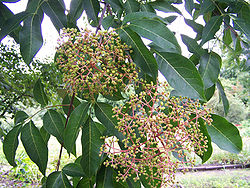Tetradium: Difference between revisions
No edit summary |
No edit summary |
||
| Line 2: | Line 2: | ||
|familia=Rutaceae | |familia=Rutaceae | ||
|genus=Tetradium | |genus=Tetradium | ||
|habit=tree | |||
|habit_ref=Wikipedia | |||
|lifespan=perennial | |||
|life_ref=Wikipedia | |||
|features=deciduous | |||
|Temp Metric=°F | |Temp Metric=°F | ||
|jumpin=If this plant info box on watering; zones; height; etc. is mostly empty you can click on the edit tab and fill in the blanks! | |jumpin=If this plant info box on watering; zones; height; etc. is mostly empty you can click on the edit tab and fill in the blanks! | ||
|image= | |image=Evodia hupehensis a1.jpg | ||
|image_width=240 | |image_width=240 | ||
|image_caption=Tetradium daniellii | |||
}} | }} | ||
'''''Tetradium''''' is a [[genus]] of nine species of [[tree]]s in the family [[Rutaceae]], occurring in temperate to tropical east [[Asia]]. In older books, the genus was often included in the related genus ''Euodia'' (orthographic error, "''Evodia''"), but that genus is now restricted to tropical species (1). In cultivation in English-speaking countries, they are known as '''Euodia''', '''Evodia''', or '''Bee bee tree'''. | |||
They are attractive [[tree]]s with [[deciduous]] glossy pinnate [[Leaf|leaves]]. ''Tetradium daniellii'' (syn. ''T. hupehensis'') develops a smooth gray bark that resembles that of a [[beech]] tree and grows to a height of 20 metres. The leaves resemble the foliage of an ash tree and are a glossy dark green in summer. In fall there is little color change and leaves tend to drop green to yellow-green. The tree is covered in late July and August with masses of large flat white to gray cluster of small white flowers, particularly valued when few other tree-size plants are flowering. It attracts large numbers of [[bee]]s and is sought after by [[beekeeping|beekeepers]] as a source of late summer [[honey]]. The flowers produce clusters of seed that is present from late August through November. The seeds start as bright red capsules that when fully ripe open to expose shiny black buckshot seed as Autumn progresses. The small, red-to-black [[Berry|berries]] are popular with many [[bird]]s. | |||
==Cultivation== | |||
===Propagation=== | |||
| | ===Pests and diseases=== | ||
''Tetradium | |||
'' | |||
'' | ==Species== | ||
Nine species including: | |||
*''[[Tetradium austrosinense]]'' - Korean Euodia | |||
*''[[Tetradium calcicola]]'' | |||
*''[[Tetradium daniellii]]'' - Korean Euodia | |||
*''[[Tetradium fraxinifolium]]'' (Hook.) T. G. Hartley | |||
*''[[Tetradium glabrifolium]]'' (Champ. ex Benth.) T. G. Hartley | |||
*''[[Tetradium ruticarpum]]'' | |||
*''[[Tetradium trichotomum]]'' | |||
==Gallery== | |||
<gallery perrow=5> | |||
Image:Upload.png| photo 1 | |||
Image:Upload.png| photo 2 | |||
Image:Upload.png| photo 3 | |||
</gallery> | |||
The | ==References== | ||
<references/> | |||
<!--- xxxxx *Flora: The Gardener's Bible, by Sean Hogan. Global Book Publishing, 2003. ISBN 0881925381 --> | |||
<!--- xxxxx *American Horticultural Society: A-Z Encyclopedia of Garden Plants, by Christopher Brickell, Judith D. Zuk. 1996. ISBN 0789419432 --> | |||
<!--- xxxxx *Sunset National Garden Book. Sunset Books, Inc., 1997. ISBN 0376038608 --> | |||
== | ==External links== | ||
* | *{{wplink}} | ||
{{ | {{stub}} | ||
__NOTOC__ | |||
Latest revision as of 23:20, 20 April 2010
| Tetradium subsp. var. | ||||||||||||||||||||||||||||||||||||||||||||||||||||||||
|---|---|---|---|---|---|---|---|---|---|---|---|---|---|---|---|---|---|---|---|---|---|---|---|---|---|---|---|---|---|---|---|---|---|---|---|---|---|---|---|---|---|---|---|---|---|---|---|---|---|---|---|---|---|---|---|---|

|
|
| ||||||||||||||||||||||||||||||||||||||||||||||||||||||
| ||||||||||||||||||||||||||||||||||||||||||||||||||||||||
Tetradium is a genus of nine species of trees in the family Rutaceae, occurring in temperate to tropical east Asia. In older books, the genus was often included in the related genus Euodia (orthographic error, "Evodia"), but that genus is now restricted to tropical species (1). In cultivation in English-speaking countries, they are known as Euodia, Evodia, or Bee bee tree.
They are attractive trees with deciduous glossy pinnate leaves. Tetradium daniellii (syn. T. hupehensis) develops a smooth gray bark that resembles that of a beech tree and grows to a height of 20 metres. The leaves resemble the foliage of an ash tree and are a glossy dark green in summer. In fall there is little color change and leaves tend to drop green to yellow-green. The tree is covered in late July and August with masses of large flat white to gray cluster of small white flowers, particularly valued when few other tree-size plants are flowering. It attracts large numbers of bees and is sought after by beekeepers as a source of late summer honey. The flowers produce clusters of seed that is present from late August through November. The seeds start as bright red capsules that when fully ripe open to expose shiny black buckshot seed as Autumn progresses. The small, red-to-black berries are popular with many birds.
Cultivation
Propagation
Pests and diseases
Species
Nine species including:
- Tetradium austrosinense - Korean Euodia
- Tetradium calcicola
- Tetradium daniellii - Korean Euodia
- Tetradium fraxinifolium (Hook.) T. G. Hartley
- Tetradium glabrifolium (Champ. ex Benth.) T. G. Hartley
- Tetradium ruticarpum
- Tetradium trichotomum
Gallery
-
photo 1
-
photo 2
-
photo 3
References
External links
- w:Tetradium. Some of the material on this page may be from Wikipedia, under the Creative Commons license.
- Tetradium QR Code (Size 50, 100, 200, 500)
